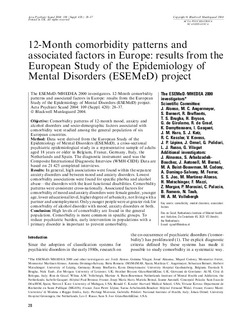| dc.contributor.author | Alonso, J. | |
| dc.contributor.author | Angermeyer, M.C. | |
| dc.contributor.author | Bernert, S. | |
| dc.contributor.author | Bruffaerts, R. | |
| dc.contributor.author | Brugha, T.S. | |
| dc.contributor.author | Bryson, H. | |
| dc.contributor.author | Vollebergh, W.A. | |
| dc.date.accessioned | 2018-05-04T11:40:54Z | |
| dc.date.available | 2018-05-04T11:40:54Z | |
| dc.date.issued | 2004 | |
| dc.identifier.citation | Alonso, J., Angermeyer, M. C., Bernert, S., Bruffaerts, R., Brugha, T. S., Bryson, H., . . . Vollebergh, W. A. (2004). 12-Month comorbidity patterns and associated factors in Europe: results from the European Study of the Epidemiology of Mental Disorders (ESEMeD) project. Acta Psychiatrica Scandinavica. Supplementum(420), 28–37. | nb_NO |
| dc.identifier.uri | http://hdl.handle.net/11250/2497196 | |
| dc.description.abstract | Objective: Comorbidity patterns of 12-month mood, anxiety andalcohol disorders and socio-demographic factors associated withcomorbidity were studied among the general population of sixEuropean countries.Method: Data were derived from the European Study of theEpidemiology of Mental Disorders (ESEMeD), a cross-sectionalpsychiatric epidemiological study in a representative sample of adultsaged 18 years or older in Belgium, France, Germany, Italy, theNetherlands and Spain. The diagnostic instrument used was theComposite International Diagnostic Interview (WMH-CIDI). Data arebased on 21 425 completed interviews.Results: In general, high associations were found within the separateanxiety disorders and between mood and anxiety disorders. Lowestcomorbidity associations were found for specific phobia and alcoholabuse—the disorders with the least functional disabilities. Comorbiditypatterns were consistent cross-nationally. Associated factors forcomorbidity of mood and anxiety disorders were female gender, youngerage, lower educational level, higher degree of urbanicity, not living with apartner and unemployment. Only younger people were at greater risk forcomorbidity of alcohol disorder with mood, anxiety disorders or both.Conclusion: High levels of comorbidity are found in the generalpopulation. Comorbidity is more common in specific groups. Toreduce psychiatric burden, early intervention in populations with aprimary disorder is important to prevent comorbidity. | nb_NO |
| dc.publisher | Acta Psychiatrica Scandinavica | nb_NO |
| dc.subject | comorbidity | nb_NO |
| dc.subject | mental disorders | nb_NO |
| dc.subject | associated factors | nb_NO |
| dc.title | 12-Month comorbidity patterns and associated factors in Europe: results from the European Study of the Epidemiology of Mental Disorders (ESEMeD) project | nb_NO |
| dc.type | Journal article | nb_NO |
| dc.source.pagenumber | 28–37 | nb_NO |
| dc.source.volume | Supplementum | nb_NO |
| dc.source.journal | Acta Psychiatrica Scandinavica | nb_NO |
| dc.source.issue | 420 | nb_NO |
| dc.identifier.doi | 10.1111/j.1600-0047.2004.00328.x | |
